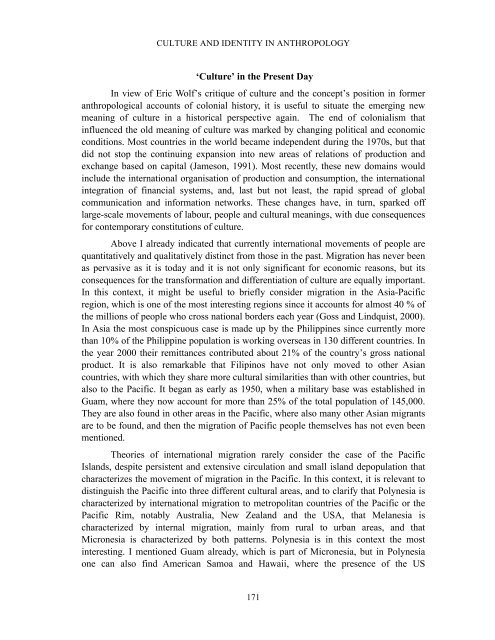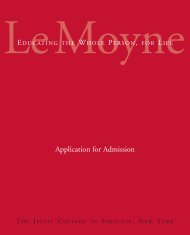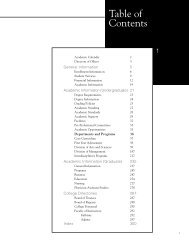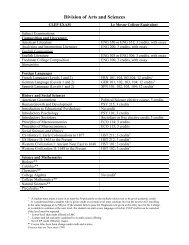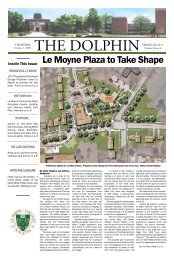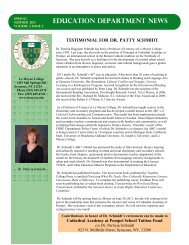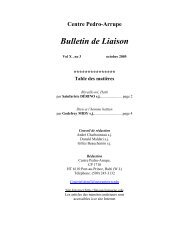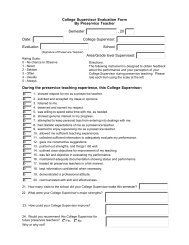165 culture and identity in anthropology: reflections on 'unity'
165 culture and identity in anthropology: reflections on 'unity'
165 culture and identity in anthropology: reflections on 'unity'
Create successful ePaper yourself
Turn your PDF publications into a flip-book with our unique Google optimized e-Paper software.
CULTURE AND IDENTITY IN ANTHROPOLOGY‘Culture’ <str<strong>on</strong>g>in</str<strong>on</strong>g> the Present DayIn view of Eric Wolf’s critique of <str<strong>on</strong>g>culture</str<strong>on</strong>g> <str<strong>on</strong>g>and</str<strong>on</strong>g> the c<strong>on</strong>cept’s positi<strong>on</strong> <str<strong>on</strong>g>in</str<strong>on</strong>g> formeranthropological accounts of col<strong>on</strong>ial history, it is useful to situate the emerg<str<strong>on</strong>g>in</str<strong>on</strong>g>g newmean<str<strong>on</strong>g>in</str<strong>on</strong>g>g of <str<strong>on</strong>g>culture</str<strong>on</strong>g> <str<strong>on</strong>g>in</str<strong>on</strong>g> a historical perspective aga<str<strong>on</strong>g>in</str<strong>on</strong>g>. The end of col<strong>on</strong>ialism that<str<strong>on</strong>g>in</str<strong>on</strong>g>fluenced the old mean<str<strong>on</strong>g>in</str<strong>on</strong>g>g of <str<strong>on</strong>g>culture</str<strong>on</strong>g> was marked by chang<str<strong>on</strong>g>in</str<strong>on</strong>g>g political <str<strong>on</strong>g>and</str<strong>on</strong>g> ec<strong>on</strong>omicc<strong>on</strong>diti<strong>on</strong>s. Most countries <str<strong>on</strong>g>in</str<strong>on</strong>g> the world became <str<strong>on</strong>g>in</str<strong>on</strong>g>dependent dur<str<strong>on</strong>g>in</str<strong>on</strong>g>g the 1970s, but thatdid not stop the c<strong>on</strong>t<str<strong>on</strong>g>in</str<strong>on</strong>g>u<str<strong>on</strong>g>in</str<strong>on</strong>g>g expansi<strong>on</strong> <str<strong>on</strong>g>in</str<strong>on</strong>g>to new areas of relati<strong>on</strong>s of producti<strong>on</strong> <str<strong>on</strong>g>and</str<strong>on</strong>g>exchange based <strong>on</strong> capital (James<strong>on</strong>, 1991). Most recently, these new doma<str<strong>on</strong>g>in</str<strong>on</strong>g>s would<str<strong>on</strong>g>in</str<strong>on</strong>g>clude the <str<strong>on</strong>g>in</str<strong>on</strong>g>ternati<strong>on</strong>al organisati<strong>on</strong> of producti<strong>on</strong> <str<strong>on</strong>g>and</str<strong>on</strong>g> c<strong>on</strong>sumpti<strong>on</strong>, the <str<strong>on</strong>g>in</str<strong>on</strong>g>ternati<strong>on</strong>al<str<strong>on</strong>g>in</str<strong>on</strong>g>tegrati<strong>on</strong> of f<str<strong>on</strong>g>in</str<strong>on</strong>g>ancial systems, <str<strong>on</strong>g>and</str<strong>on</strong>g>, last but not least, the rapid spread of globalcommunicati<strong>on</strong> <str<strong>on</strong>g>and</str<strong>on</strong>g> <str<strong>on</strong>g>in</str<strong>on</strong>g>formati<strong>on</strong> networks. These changes have, <str<strong>on</strong>g>in</str<strong>on</strong>g> turn, sparked offlarge-scale movements of labour, people <str<strong>on</strong>g>and</str<strong>on</strong>g> cultural mean<str<strong>on</strong>g>in</str<strong>on</strong>g>gs, with due c<strong>on</strong>sequencesfor c<strong>on</strong>temporary c<strong>on</strong>stituti<strong>on</strong>s of <str<strong>on</strong>g>culture</str<strong>on</strong>g>.Above I already <str<strong>on</strong>g>in</str<strong>on</strong>g>dicated that currently <str<strong>on</strong>g>in</str<strong>on</strong>g>ternati<strong>on</strong>al movements of people arequantitatively <str<strong>on</strong>g>and</str<strong>on</strong>g> qualitatively dist<str<strong>on</strong>g>in</str<strong>on</strong>g>ct from those <str<strong>on</strong>g>in</str<strong>on</strong>g> the past. Migrati<strong>on</strong> has never beenas pervasive as it is today <str<strong>on</strong>g>and</str<strong>on</strong>g> it is not <strong>on</strong>ly significant for ec<strong>on</strong>omic reas<strong>on</strong>s, but itsc<strong>on</strong>sequences for the transformati<strong>on</strong> <str<strong>on</strong>g>and</str<strong>on</strong>g> differentiati<strong>on</strong> of <str<strong>on</strong>g>culture</str<strong>on</strong>g> are equally important.In this c<strong>on</strong>text, it might be useful to briefly c<strong>on</strong>sider migrati<strong>on</strong> <str<strong>on</strong>g>in</str<strong>on</strong>g> the Asia-Pacificregi<strong>on</strong>, which is <strong>on</strong>e of the most <str<strong>on</strong>g>in</str<strong>on</strong>g>terest<str<strong>on</strong>g>in</str<strong>on</strong>g>g regi<strong>on</strong>s s<str<strong>on</strong>g>in</str<strong>on</strong>g>ce it accounts for almost 40 % ofthe milli<strong>on</strong>s of people who cross nati<strong>on</strong>al borders each year (Goss <str<strong>on</strong>g>and</str<strong>on</strong>g> L<str<strong>on</strong>g>in</str<strong>on</strong>g>dquist, 2000).In Asia the most c<strong>on</strong>spicuous case is made up by the Philipp<str<strong>on</strong>g>in</str<strong>on</strong>g>es s<str<strong>on</strong>g>in</str<strong>on</strong>g>ce currently morethan 10% of the Philipp<str<strong>on</strong>g>in</str<strong>on</strong>g>e populati<strong>on</strong> is work<str<strong>on</strong>g>in</str<strong>on</strong>g>g overseas <str<strong>on</strong>g>in</str<strong>on</strong>g> 130 different countries. Inthe year 2000 their remittances c<strong>on</strong>tributed about 21% of the country’s gross nati<strong>on</strong>alproduct. It is also remarkable that Filip<str<strong>on</strong>g>in</str<strong>on</strong>g>os have not <strong>on</strong>ly moved to other Asiancountries, with which they share more cultural similarities than with other countries, butalso to the Pacific. It began as early as 1950, when a military base was established <str<strong>on</strong>g>in</str<strong>on</strong>g>Guam, where they now account for more than 25% of the total populati<strong>on</strong> of 145,000.They are also found <str<strong>on</strong>g>in</str<strong>on</strong>g> other areas <str<strong>on</strong>g>in</str<strong>on</strong>g> the Pacific, where also many other Asian migrantsare to be found, <str<strong>on</strong>g>and</str<strong>on</strong>g> then the migrati<strong>on</strong> of Pacific people themselves has not even beenmenti<strong>on</strong>ed.Theories of <str<strong>on</strong>g>in</str<strong>on</strong>g>ternati<strong>on</strong>al migrati<strong>on</strong> rarely c<strong>on</strong>sider the case of the PacificIsl<str<strong>on</strong>g>and</str<strong>on</strong>g>s, despite persistent <str<strong>on</strong>g>and</str<strong>on</strong>g> extensive circulati<strong>on</strong> <str<strong>on</strong>g>and</str<strong>on</strong>g> small isl<str<strong>on</strong>g>and</str<strong>on</strong>g> depopulati<strong>on</strong> thatcharacterizes the movement of migrati<strong>on</strong> <str<strong>on</strong>g>in</str<strong>on</strong>g> the Pacific. In this c<strong>on</strong>text, it is relevant todist<str<strong>on</strong>g>in</str<strong>on</strong>g>guish the Pacific <str<strong>on</strong>g>in</str<strong>on</strong>g>to three different cultural areas, <str<strong>on</strong>g>and</str<strong>on</strong>g> to clarify that Polynesia ischaracterized by <str<strong>on</strong>g>in</str<strong>on</strong>g>ternati<strong>on</strong>al migrati<strong>on</strong> to metropolitan countries of the Pacific or thePacific Rim, notably Australia, New Zeal<str<strong>on</strong>g>and</str<strong>on</strong>g> <str<strong>on</strong>g>and</str<strong>on</strong>g> the USA, that Melanesia ischaracterized by <str<strong>on</strong>g>in</str<strong>on</strong>g>ternal migrati<strong>on</strong>, ma<str<strong>on</strong>g>in</str<strong>on</strong>g>ly from rural to urban areas, <str<strong>on</strong>g>and</str<strong>on</strong>g> thatMicr<strong>on</strong>esia is characterized by both patterns. Polynesia is <str<strong>on</strong>g>in</str<strong>on</strong>g> this c<strong>on</strong>text the most<str<strong>on</strong>g>in</str<strong>on</strong>g>terest<str<strong>on</strong>g>in</str<strong>on</strong>g>g. I menti<strong>on</strong>ed Guam already, which is part of Micr<strong>on</strong>esia, but <str<strong>on</strong>g>in</str<strong>on</strong>g> Polynesia<strong>on</strong>e can also f<str<strong>on</strong>g>in</str<strong>on</strong>g>d American Samoa <str<strong>on</strong>g>and</str<strong>on</strong>g> Hawaii, where the presence of the US171


